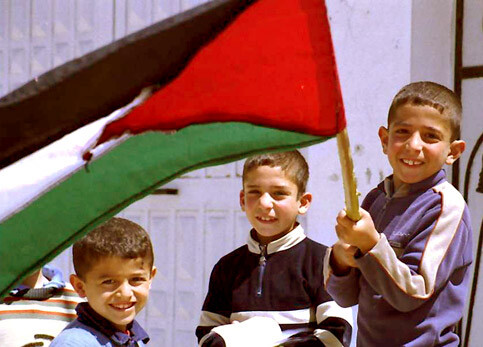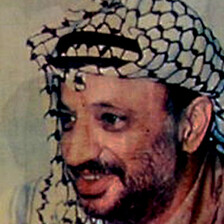
“I suddenly remember that some twenty years ago, in the 1980s, the Israelis forbade the Palestinians to even color the Palestinian flag, let alone to hoist it in the streets. The flag was considered a danger to public order.” (Helga Tawil)
Jara asked Mary whether Jesus could touch Arafat’s hand and let him walk. She was influenced by the religious lessons and Biblical miracles she hears about from her nun teachers at St Joseph’s. When Mary explained that Jesus can do much but not make Arafat alive, Jara decided that she wanted to do something by her own, out of her feelings for Arafat, and she went on to make a flag. Earlier Mary had said that she regretted not having a black flag at home, and so Jara went looking for black crayons to paint her own flag on a large piece of paper. However, she couldn’t find enough good black paint to cover a whole page; there was only kohl, the black powder used for accentuating the Arab woman’s eyes. However, that was a bit too expensive. So she settled for drawing a multi-colored Palestinian flag. For almost a week now her paper flag is proudly on public display at the gate of my family in law’s house.
In fact, both Jara and Tamer feel strongly about the Palestinian flag. A few months ago I had bought two small flags at a book store since the both kids were planning to construct a tent on the balcony, and we needed something to top it off. To silence them, I thought to have found a nice decoration, but no, the next hour all spots in the house, high and low, were tried out to judge their aptitude for raising the flags. And of course the kids were fighting afterwards to keep the flags for themselves.
In commemoration of Arafat, Mary joined a march on Friday with some two thousand mourners. Afterwards she pointed out to me, disapprovingly, that only Tamer had represented the Dutch nation in the march. Moreover, the Dutch nation was heavy; Mary got a painful back of carrying Tamer for several hours. I felt a pang of repentance for not joining, especially after seeing that at Arafat’s funeral in Ramallah there were flags from several countries, including a French flag with a thank you to President Chirac for the statesman-like farewell that France had arranged when Arafat’s body was flown away. Symbolism doesn’t bring independence but it definitely evokes feelings of pride and respect.
At present Jara is studying her Arabic lessons at elementary level, grade two. She reads a story about the Palestinian Independence Day, 15 November. I study the book with her to improve my own Arabic. In the story a boy with a bag full of Palestinian flags goes early morning to his friend to ask him to help raising the flags along the lines spanning the streets. His friend hesitates because people in Palestine often shoot in the air during celebrations and it may be dangerous to go out. No, the boy tells his friend, the authorities have announced that it is now strictly forbidden to shoot at Independence Day. Relieved by this message, the friend joins.
I wonder what the girls in Jara’s class are thinking when reading this story. To what extent can the authorities guarantee public safety during such events? My Arabic teacher says that it was a shame that people could not restrain themselves during the last farewell to Arafat in Ramallah. It was fawda, chaos.
I suddenly remember that some twenty years ago, in the 1980s, the Israelis forbade the Palestinians to even color the Palestinian flag, let alone to hoist it in the streets. The flag was considered a danger to public order. During the first Intifada Israeli soldiers forced Palestinian citizens to paint over Palestinian flags that covered the walls of the streets. Mary still remembers those days very well. Painters sometimes circumvented the prohibition by showing a Palestinian salad containing the colors of the flag: black and green in the olives, red in the tomatoes, and white in the cheese. Or women’s embroidery containing those colors.
During the free days of mourning and the Moslem ‘Eid al-Fitr, I decide to go with Jara and Tamer to the zoo in Jerusalem since it is beautiful weather. Of course Mary is unable to join as she does not have a permit. We call Fadi , the taxi driver, to bring us to the checkpoint. Outside our house, in front of ‘Azza refugee camp, we see the fires lightening up from big piles of garbage. Presently nobody picks up the garbage at the refugee camps so long as the strike of the UNRWA workers (including the teachers, health workers etc.) goes on. The UNRWA administration even refuses to talk with the employees’ union, who asks for a better insurance and labor conditions. There is no money. Now people put fires in the garbage to prevent the spread of stench and diseases.
Of course everywhere are black flags as well as Palestinian flags, some of them not real flags but pieces of textile provisionally attached to sticks. They hang over the streets and are put on the cars. Fadi, too, carries a black flag on his taxi, which he quickly removes after hearing that we are heading for the checkpoint. The Israeli soldiers may not like it, and may keep him there for a few hours, or otherwise make life difficult for him. My skeptical instinct says that Fadi puts the flag primarily to maintain good relations with the authorities, but it is also possible that his feelings are genuine. He is always polite, so we don’t know. At the place where the taxi can’t go further the kids and I start walking some 200 meters across an almost desolated landscape towards the checkpoint. These days very few Palestinians from the West Bank can obtain a permit to enter Jerusalem.
To keep the children relaxed, I take Tamer on my shoulders. Tamer in any case feels happy; he greatly enjoys the sight of all those big machines – bulldozers, diggers, and so on - working on constructions nearby the Wall which are designed to make Bethlehem even more of a prison. But in this desert-like environment where the big blue flag on top of the approaching checkpoint is the only thing colorful, Jara, who is older, says that she is afraid. I try to explain to her that when you keep yourself calm the soldiers at the checkpoint will not shoot but will just say “yes” or “no” when you show the passport or ID card. After all, there is nobody, so why should they shoot at us? Jara remains unconvinced. We pass the checkpoint – it used to take 15-30 or more minutes, but now it takes no time at all because there are really no people –and we walk another 200 meter to stop an Israeli taxi. The Jewish-Orthodox driver has an Israeli flag waving before the window of the car. To my knowledge there is no Israeli feast that day, but frankly one looses track of the Israeli autumn feast days which never seem to come to an end. The driver doesn’t look happy when he hears Jara speaking Arabic with Tamer, but I look sufficiently foreign to be allowed into the car.
We enjoy the zoo as always. It is a place where you hear both Hebrew and Arabic (from Palestinians living in East-Jerusalem or in Israel), and occasionally other languages. Jara feels comfortable there. Upon returning home, Mary asks Tamer whether he saw the jaysh, the army, at the checkpoint. Yes, he says, adding in a disappointed, low voice, “they didn’t shoot.” As if a great game was denied him. In the garden he makes use of everything available to imitate a pistol, such as a toy hairdryer, a piece of bark from the tree, or clothes pegs. He then bends himself a little backwards, stretches his arms in front of him holding the object, and imitates exploding sounds. “Allah yustur” (“May God protect us”), Mary sighs. Seeing that Mary wears a long black dress suitable for mourning occasions, Jara tells her that she exactly looks like the Jewish-Orthodox women in the zoo.
Toine van Teeffelen is development director at the Arab Educational Institute (AEI) in Bethlehem and local coordinator of United Civilians for Peace.




